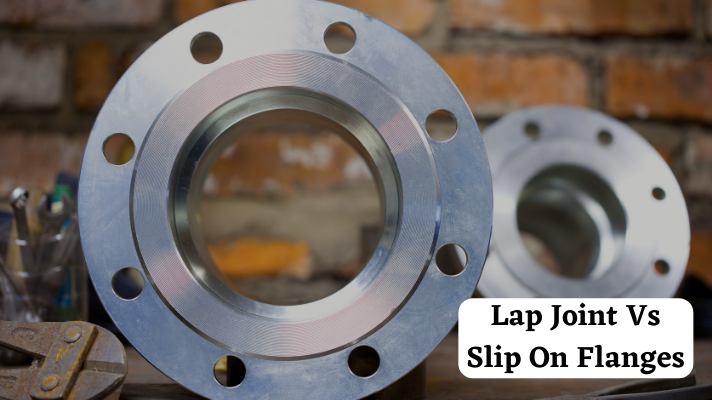
A pipe flange uses bolted connectors and gaskets to connect pipes and components in a plumbing system. Flanges are the second most often used after welding, providing a dependable means to link pipe systems with the different equipment, valves, and other components of practically any processing system.
Lap Joint flanges, Weld neck flanges, slip on flanges, blind flanges, socket weld flanges, threaded flanges, are the most widely used type of flanges (RTJ Flange). These types of flanges or connections make it easy for disassembly and separation for repairs and regular maintenance. In this article, we will compare two of the most common types of flanges that are used i.e., Lap Joint flange and Slip on flange.
Lap joint flange and slip-on flange are often confused because they seem so similar; with the distinction that lap joint flange dimension has circular edges on the rear side and a flat face, while a Slip on flange dimensions does not. Before getting into the comparison between Lap Joint flanges vs. Slip on flange lets first understand each separately:
Slip On Flange
Also referred to as ANSI Flanges or ASME B16.5 Flanges, a slip on flange is intended to be slipped over the end of a pipe. It enables for simple placement prior to welding. The slip on flange is welded on both the inside and outside of the pipe. The pipe is typically put all the way within the slip on flange, leaving just a space equal to the pipe's wall thickness.
Lap Joint Flange
A lap joint flange very much similar to a slip-on flange but is typically a two-piece flange of which one piece is called a Stub End and second piece is called a Hub. The Stub-end is a small section of pipe with a weld bevel on one end and a narrow shoulder called the hub on the other. The hub has the same outer diameter as a weld neck flange's raised face. The width of the hub is ranges between 14" and 3/8". A rounded transition (or inner fillet) connects the hub to the sleeve on the back face of the hub.
Lap Joint Flanges Vs Slip On Flanges
Apart from the differences of edges and the face of the flanges, Lap joint flange dimensions are also different than that of Slip-on flange dimensions. Also, both have are manufactured for precise purposes which cannot be replicated by the other.
Lap joint flanges and stub-end assemblies are common solution in circumstances where regular disassembly and inspection is required. Because of its two-piece design, the Lap Joint Flange might help you save money or simplify your labour. When pipe is built of exotic materials, lap joint flanges may be an alternative for cost savings.
The wetted materials would be exotic materials, while the flange would be carbon steel, if a lap joint flange was used. The fluids would have no effect on the flange because it never comes into touch with the process fluid. Lap joint flanges are often utilised in low-pressure applications and are not recommended when the flange pair is subjected to severe stresses. Lap joint flanges are required for certain types of pipes. Lap joint flanges, for example, can be seen on metallic pipe with a plastic liner.
Like, the Lap Joint, Slip on flanges is also preferred for low pressure flow joints, because the flange has a low shock and vibration resistance. They are less expensive to buy, but the extra cost of the two fillet welds necessary for appropriate installation raises the total cost. A slip-on flange is slid over the pipe and fillet welded. In fabricated applications, slip-on flanges are simple to employ. A Slip on flange is preferred on account of its reduced precision requirement in cutting the pipe to length; it facilitates easy alignment of the assembly.
Conclusion
Though similar, both types of flanges are unique and designed for specific application. These flanges increase flexibility in pipe system maintenance by allowing for easier disassembly and increased access to system components. ANSI B16.5 / ASME B16.5 are the most accepted specification for carbon steel and stainless steel flanges. Flanges made of metal are extensively utilised in industrial, commercial, and institutional settings.
At Shacha Technoforge, metal pipe flanges are available in a wide range of designs and pressure ratings that complies with the certified standards. Metal flanges are rated from 150 to 2500 pounds per square inch. Shacha Technoforge has a large selection of carbon steel, stainless steel, and nickel alloy pipe flanges.
